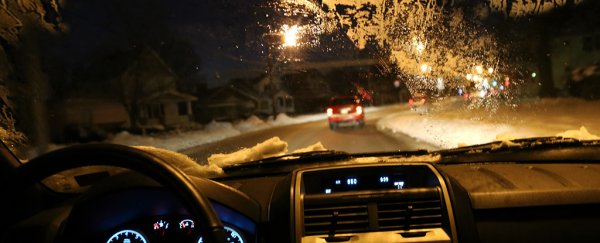COVID-19 put a spotlight on personal health and safety like perhaps only a pandemic can, but there was one place at least where people didn't get the memo: American roads.
Despite Americans driving hundreds of billions of miles less in 2020 than they did in 2019, deadly traffic accidents actually surged in the year of lockdown, with crash fatalities during the pandemic hitting levels not seen in over a decade.
According to the US Department of Transportation's National Highway Traffic Safety Administration (NHTSA), traffic fatality projections for 2020 suggest an estimated 38,680 people died in motor vehicle traffic crashes last year, representing an increase of about 7.2 percent on 2019's fatalities.
That staggering rise – taking traffic fatalities to levels not seen since 2007 – came during a year in which Americans actually drove their cars much less than usual: an estimated 430.2 billion miles less traveled overall, representing a 13.2 percent decrease from the year before.
The new figures show that traveling on the nation's roads last year was a significantly riskier proposition overall compared to recent years, with the fatality rate per 100 million vehicle miles traveled (VMT) surging to 1.37 in 2020, up from 1.11 in 2019, and ending a string of yearly reductions in fatality rates that began in 2016, suggesting safer driving conditions.
That good run now appears to be interrupted. Even though an in-depth psychological explanation for what's happening is beyond the scope of the NHTSA's statistics, the body did become aware of a dangerous shift in driver behavior several months ago.
"During the early months of the national public health emergency, driving patterns and behaviors changed significantly," the NHTSA explained in an update on COVID-19 traffic safety conditions in January.
"Of the drivers who remained on the roads, some engaged in riskier behavior, including speeding, failing to wear seat belts, and driving under the influence of alcohol or other drugs."
The newest figures, released last week, give the most comprehensive look yet at traffic fatalities in the US in 2020, showing that the deadliest months came in the second half of the year, after states began reopening following earlier shutdowns and stay at home orders in the first half of 2020 (which coincided with less traffic fatalities in the months of March, April, and May, compared to 2019).
While it's difficult to authoritatively pin down what made people drive in more dangerous ways, the NHTSA acknowledges a "remarkable trend" of several worsening factors contributed to the surge in deadly crashes last year.
These included significant increases in fatalities on rural, urban, and interstate roads, fatalities at night-time and on weekends, crashes involving older vehicles, rollover crashes, speeding-related crashes, and many more.
The greatest increases over 2019 figures were fatalities involving non-Hispanic Black people (up 23 percent), occupant ejection (up 20 percent), and unrestrained occupants of passenger vehicles (up 15 percent, and tied with fatalities on urban interstate roads).
Not every aspect of US driving in 2020 was deadlier. Fatalities involving older people (aged 65 and older) declined by 9 percent, and deaths involving large trucks fell marginally (by about 2 percent).
According to the NHTSA, traffic data suggest average driver speeds increased in Q2 and Q3 of the year, and extreme speeds became more common, even while people in crashes seemed to be using their seat belts less. Drug use was also a significant factor.
"NHTSA's study of seriously or fatally injured road users at five participating trauma centers found that almost two-thirds of drivers tested positive for at least one active drug, including alcohol, marijuana, or opioids between mid-March and mid-July," a new report explains.
"The proportion of drivers testing positive for opioids nearly doubled after mid-March, compared to the previous six months, while marijuana prevalence increased by about 50 percent."
Ultimately, the NHTSA says the increases in risky traffic safety behaviors first seen in Q2 and Q3 continued on in the last quarter of the year, meaning that even though the frequency of trip-taking overall declined, a "disturbing trend" of increases in severe injury rates throughout the latter part of 2020 resulted.
"Addressing the needs of vulnerable road users requires that we understand how their risks might have changed during 2020," the NHTSA says, noting that much more additional research is needed to help explain shifts in driver behavior and resulting crash outcomes.
Drive safely, everyone. People's lives really do depend upon it.
The findings are available on the NHTSA's website.
